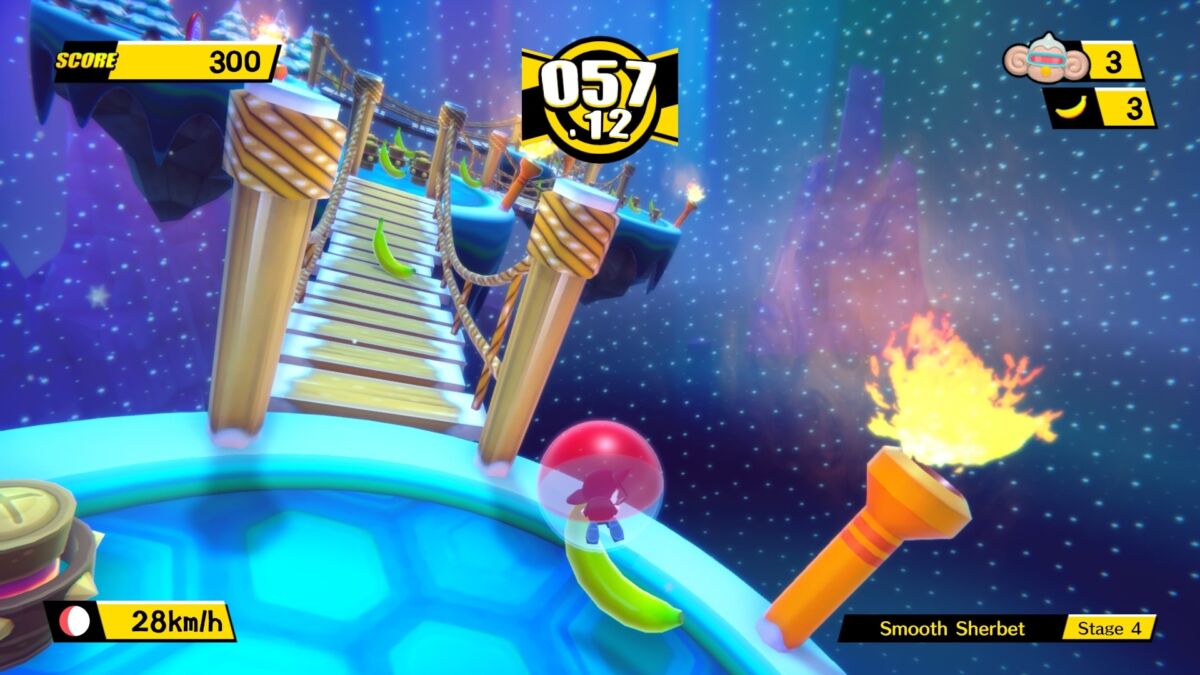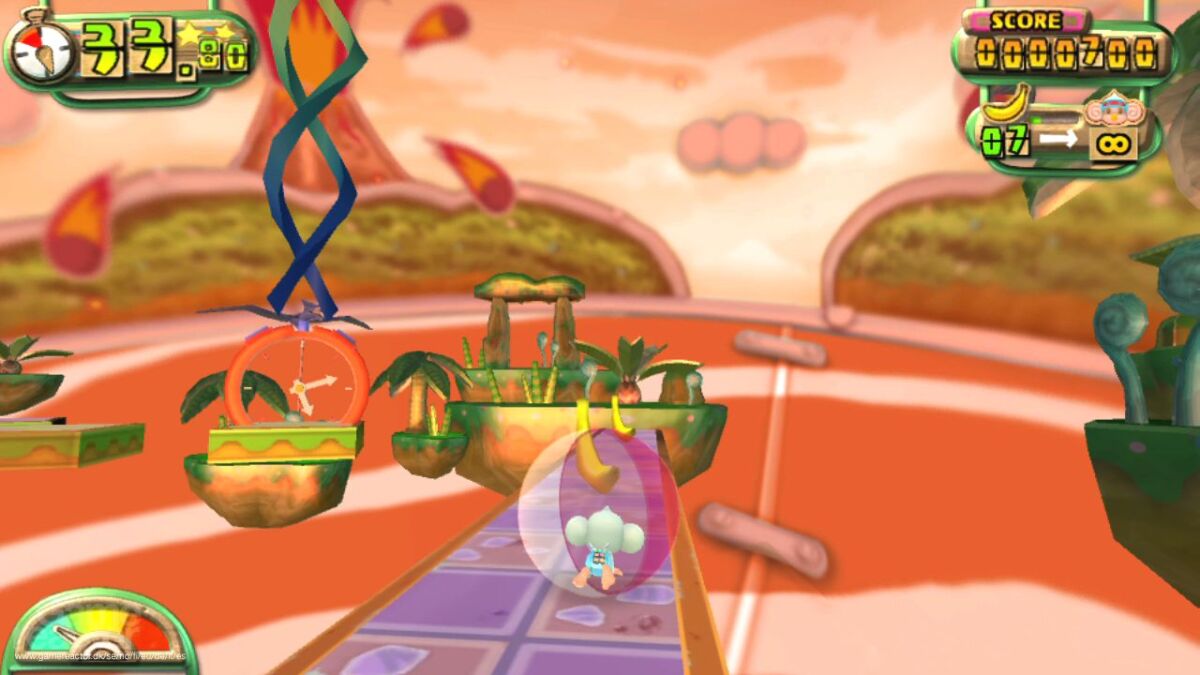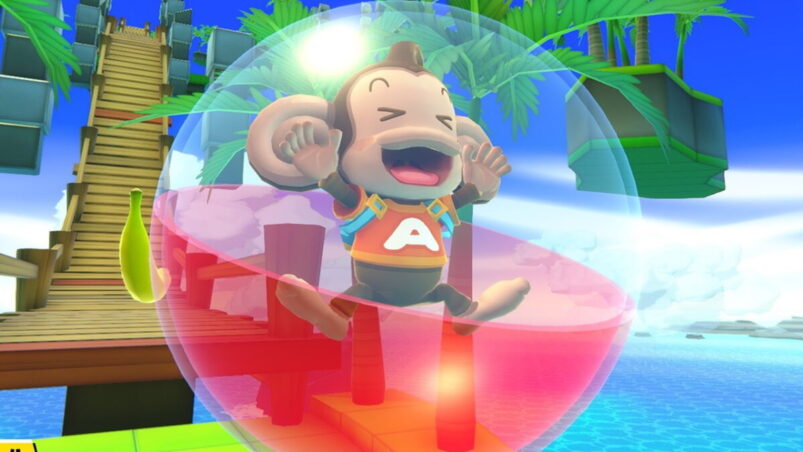In real life, stuffing a monkey into a sealed plastic ball is a good way to see the inside of a courtroom. In the land of gaming, it’s more fun than it has any right to be.
Super Monkey Ball is a venerable enough franchise that it began as an arcade cabinet in the vein of Atari’s ancient Marble Madness. It set the standard for all that was to follow – rather than controlling your monkey, the analog stick would tilt the level itself, and your monkey would roll where it may. You’d negotiate it around increasingly challenging and often quite precarious courses towards the goal.
It is the precision needed to get your monkey across razor-thin pathways which makes the games so maddening – and so satisfying. Monkey Ball holds the rare distinction of being a game which is provably good for hand-eye coordination, to a literally surgical level.
While making your way through each level, your monkey will want to collect as many bananas as possible, just like the cartoons. This is why Monkey Ball is one of very few game franchises to have been sponsored by real-life fruit company Dole, one of the businesses which put the ‘banana’ in ‘banana republic’, and able to trace its heritage back to the Hawaiian Pineapple Company and James Dole, cousin of the man who overthrew the monarchy of Hawaii. Don’t worry about that, though, focus on the monkeys as we look back on the history of the Super Monkey Ball franchise.
Super Monkey Ball: A Short History
Golden Howler Monkey Days (Super Monkey Ball, Super Monkey Ball 2, Super Monkey Ball Deluxe)

Super Monkey Ball brought all the monkey action to home consoles – notably, the GameCube. This was just after the Dreamcast was finally put out to pasture in 2001, and was Sega’s first release on a Nintendo console.
Super Monkey Ball also included a stack of minigames, some of which were just taking advantage of spherical objects being built right in (Monkey Bowling, Monkey Snooker), and one which was just the developers throwing up their hands and saying “look, you can’t be bothered switching over to Mario Kart” (Monkey Race). The strongest of the lot was clearly Monkey Target, where the balls finally opened up – and, what’s more, became glider-style wings.
Super Monkey Ball drew glowing reviews across the board. Edge summarised it as “genius”, and Gamespy’s main complaint was hyperbolic concerns about how the monkeys could possibly breathe inside their balls. It would ultimately see itself ported several times over, making its way to Nokia’s handheld console the N-Gage, the Game Boy Advance (as Super Monkey Ball Jr.), and, much later, to the iOS.
Next year, 2002 saw Super Monkey Ball 2 turning up the volume on its main game, with the levels becoming increasingly outlandish and more likely to send your monkey hurtling, terrified, through the air, introducing special fun buttons to speed or slow the passage of time. It also introduced a story of sorts, involving the sinister Dr. Bad-Boon wanting to kidnap token female monkey MeeMee, though this was mainly a way to string the different worlds together.
It also added six more minigames to the existing roster, with Tennis generally highlighted as the best. As with the original, these were far stronger as multiplayer affairs, with several people gathered around the one screen screaming in either fury or victory.
Like the first, Super Monkey Ball 2 drew rave reviews across the board – often, even better ones than its predecessor. IGN reckoned it was “Bigger. Packed with more options. More refined. Prettier”, and concluded “Sega has outdone itself.” Next Generation listed it as one of their best 100 games of the 21st century, and ranked it as the 80th best-selling game for the PlayStation 2, Xbox or GameCube – particularly impressive for a GameCube exclusive.
Super Monkey Ball Deluxe brought the franchise to the Xbox and PlayStation in 2005, combining all the levels of Super Monkey Balls 1 and 2 as well as adding a few more. Simply put, it was exactly what you might want from a port. It garnered reviews that were well above average, though never cracked the same lofty heights as its predecessors. Which is ironic, because as G4TV noted, “If you’ve played it before on GameCube, you’ve seen it all before” – though they did have to admit that, having combined the meat of 1 and 2, there was “a whole lot of monkey balling to be had for your buck”.
Peripheral Proboscis Monkeys (Super Monkey Ball Touch & Roll, Super Monkey Ball Adventure)

Super Monkey Ball Touch & Roll brought the game to the Nintendo DS later in 2005 – and used the touchscreen to control the levels. Although you could use the D-pad as well, this brought in a more physical, visceral element to it, harking back to those funny tilty-marble games which are surely where all this began. Or at least, that was the intention. In practice, poking at a flat screen with a stylus, it ended up more detached than using conventional game controls.
The DS, like many of Nintendo’s more experimental projects, had a first-mover’s disadvantage. Sometimes the touchscreen really added something – but sometimes it was a millstone. As Eurogamer described it, “the lack of tactile or visual feedback from the stylus means you pick up too much speed and tend to roll off edges, not pull up sharply enough, and generally fail to control the ball”. And the alternative of the D-pad wasn’t much better, lacking the precision of an analogue stick.
Super Monkey Ball Touch & Roll was also still experimenting with the minigame roster, bringing in Air Hockey and the first-person-shooter War – but leaving out Target, the obvious GOAT. These new additions were greeted as middling at best, which matched the fairly tepid reviews. Even Gamesradar’s fairly generous 3.5 out of 5 rating included a hefty caveat about the touchscreen controls. Gamespy’s harsher review concluded “Monkey Ball shouldn’t bother leaving the console systems”.
After the franchise’s ill-fated flirtation with touchscreen controls, you might expect its next release, 2006’s Super Monkey Ball Adventure, to get back to basics, and return to what they knew would work. Instead, it almost completely jettisoned the physics puzzles in favour of turning it into a platformer adventure.
On the one hand, after five years beating their heads against the same format, you can understand why they might try something different. But on the other hand, the best-praised element of Super Monkey Ball Adventure was the soundtrack, which should tell you something.
IGN seemed to summarise the broader consensus pretty well when they said “We just want to play the damned puzzle mazes” . Its average rating hovered at around a 5 out of 10, and Rotten Tomatoes gave it a rare score of 0%. This, clearly, was not the right route.
Motion-Sensitive Macaques (Super Monkey Ball: Banana Blitz, Super Monkey Ball: Step & Roll)

Released as a Wii launch title in 2006, Super Monkey Ball: Banana Blitz incorporated the motion-sensitive Wiimote, which, after the franchise’s touchscreen debacle, you might well have greeted with suspicion. But it defied expectations, and though the Wiimote controls were tricky to master and weren’t popular with everyone, they did provide the kind of sensitivity the game needed, with IGN actually hailing them as superior to the old control schemes.
The different monkeys had always handled slightly differently, but this really meant something with the WiiMote, with Baby responding to the smallest movement, while the heavier GonGon needed the WiiMote to be turned almost vertically to get moving. It also saw a revamp of the art style – no immense departure, but a slightly more streamlined, cel-shaded style which fit the intrinsically cartoony concept of monkeys in balls rolling around after bananas.
Beyond the main game, Super Monkey Ball: Banana Blitz went for broke and bumped its crop of minigames up to fully fifty – although this was very much a ‘throw stuff at the wall and see what sticks’ approach, since their quality was described as “wildly inconsistent”. Even less popular was its introduction of boss battles, which were repetitive at best.
Nevertheless, Super Monkey Ball: Banana Blitz attracted some of the best reviews the franchise had received for some time, with many rating it comfortably over 80% – a bit of a coup after the disaster of Super Monkey Ball Adventure. Later on, in 2019, it was still popular enough to merit an HD remake for Nintendo Switch, PlayStation 4, and Xbox One, and, shortly thereafter, for the PC.
2010’s Super Monkey Ball: Step & Roll still used the motion-sensitive WiiMote, but also allowed players to use the Wii Balance Board to move the level. It was against this choice that much of the criticism was slung. Eurogamer did not mince their words, saying “the box says Step & Roll is “compatible with” the Wii balance board. It does not say “playable with”; this is because that statement would represent a violation of the Trade Descriptions Act.”
Particularly damning was the fact that, when using the Balance Board, levels would feature far fewer obstacles – in other words, they needed to be easier to have a hope in hell of completing them with this clunkier controller, and the developers knew it. Even IGN’s largely positive review had to concede “skip the balance board support and you’ll have a good time” .
Perhaps most remarkably, Super Monkey Ball: Step & Roll saw the franchise’s fruit-baron patron change from Dole to Chiquita, formerly known as the United Fruit Company – although they are not Dole’s enemies in any meaningful sense, since the two companies came together to fund Colombian terrorist groups in the 1990s. Look, try not to think about it. Focus on the monkeys.
Portable Primates (Super Monkey Ball 3D, Super Monkey Ball: Banana Splitz)

Buoyed by the success of the Monkey Ball-WiiMote combo, 2011’s Super Monkey Ball 3D allowed players to use the 3DS’s internal gyroscope – but this ended up more like Step & Roll, with levels having to clumsily compensate for there being two possible control schemes. And, to add a further turd to the waterpipe, having to turn the console this way and that to work the gyroscope rendered the 3D effects basically unusable.
Super Monkey Ball 3D’s reviews found themselves starkly divided – and the more positive ones tended to be hedging their bets a little. Even Gamechronicles’s 8.4 out of 10 review reckoned it was better as a means of showing of the capabilities of the 3DS, rather than a game in and of itself . Meanwhile, the more negative reviews heard in it a death knell for the franchise, suggesting “the magic may be gone for good”.
Super Monkey Ball: Banana Splitz was released in 2012 on the PS Vita, Sony’s second attempt to carve off a slice of the handheld console market – a market which was by then being badly flanked by the rise of smartphones. And while Super Monkey Ball: Banana Splitz was never going to change that, it was a surprising bright spot in a franchise which had been listing for a while.
Super Monkey Ball: Banana Splitz’s one stab at originality, something which the franchise had been facing a drought of for a while, was the ability to create custom maps. Unfortunately, it did this by having the player provide a picture, and letting its own algorithms puzzle out exactly how it translated into the game. This rarely worked, and, as Gamespot noted, this mode should very obviously have actually let the player actually create maps themselves.
The Vita, like several of the consoles mentioned above, was motion-sensitive, and brought this method of control to Super Monkey Ball: Banana Splitz. This time they spawned a relatively even split of critical opinion: IGN thought this was the best way to play it, Hardcore Gamer found it woefully imprecise. Nonetheless, Super Monkey Ball: Banana Splitz drew in better reviews than might have been expected – nothing world-beating, but above average, with even the harshest reviews admitting that by now they had nailed the solo mode.
The upcoming Super Monkey Ball: Banana Mania is intended as a bit of a celebration of the franchise’s twentieth anniversary. Like Super Monkey Ball Deluxe before it, it’s a remaster of a lot of the old levels – which, given how the franchise’s attempts to branch out have gone, is likely a good choice. If there’s one thing we’ve learned over the history of Super Monkey Ball, it’s that it’s a wheel which does not need reinventing. Just give us some tricky levels well-stocked with bananas, and you’re away.
READ MORE: I Hate & Love That Jumping Is In Super Monkey Ball: Banana Mania
Some of the coverage you find on Cultured Vultures contains affiliate links, which provide us with small commissions based on purchases made from visiting our site. We cover gaming news, movie reviews, wrestling and much more.



